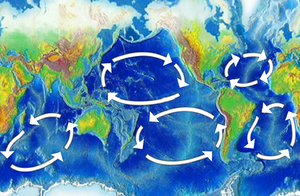
An ocean current is a continuous, directed movement of sea water generated by a number of forces acting upon the water, including wind, the Coriolis effect, breaking waves, cabbeling, and temperature and salinity differences. Depth contours, shoreline configurations, and interactions with other currents influence a current's direction and strength. Ocean currents are primarily horizontal water movements.

In oceanography, a gyre is any large system of circulating ocean currents, particularly those involved with large wind movements. Gyres are caused by the Coriolis effect; planetary vorticity, horizontal friction and vertical friction determine the circulatory patterns from the wind stress curl (torque).

Marine debris, also known as marine litter, is human-created waste that has deliberately or accidentally been released in a sea or ocean. Floating oceanic debris tends to accumulate at the center of gyres and on coastlines, frequently washing aground, when it is known as beach litter or tidewrack. Deliberate disposal of wastes at sea is called ocean dumping. Naturally occurring debris, such as driftwood and drift seeds, are also present.

The North Atlantic Gyre of the Atlantic Ocean is one of five great oceanic gyres. It is a circular ocean current, with offshoot eddies and sub-gyres, across the North Atlantic from the Intertropical Convergence Zone to the part south of Iceland, and from the east coasts of North America to the west coasts of Europe and Africa.

The North Pacific Gyre (NPG) or North Pacific Subtropical Gyre (NPSG), located in the northern Pacific Ocean, is one of the five major oceanic gyres. This gyre covers most of the northern Pacific Ocean. It is the largest ecosystem on Earth, located between the equator and 50° N latitude, and comprising 20 million square kilometers. The gyre has a clockwise circular pattern and is formed by four prevailing ocean currents: the North Pacific Current to the north, the California Current to the east, the North Equatorial Current to the south, and the Kuroshio Current to the west. It is the site of an unusually intense collection of human-created marine debris, known as the Great Pacific Garbage Patch.

The Great Pacific garbage patch is a garbage patch, a gyre of marine debris particles, in the central North Pacific Ocean. It is located roughly from 135°W to 155°W and 35°N to 42°N. The collection of plastic and floating trash originates from the Pacific Rim, including countries in Asia, North America, and South America. The gyre is divided into two areas, the "Eastern Garbage Patch" from California to Hawaii, and the "Western Garbage Patch" extending from Hawaii to Japan.
A garbage patch is a gyre of marine debris particles caused by the effects of ocean currents and increasing plastic pollution by human populations. These human-caused collections of plastic and other debris, cause ecosystem and environmental problems that affect marine life, contaminate oceans with toxic chemicals, and contribute to greenhouse gas emissions. Once waterborne, marine debris becomes mobile. Flotsam can be blown by the wind, or follow the flow of ocean currents, often ending up in the middle of oceanic gyres where currents are weakest. Garbage patches grow because of widespread loss of plastic from human trash collection systems.

Marine plastic pollution is a type of marine pollution by plastics, ranging in size from large original material such as bottles and bags, down to microplastics formed from the fragmentation of plastic material. Marine debris is mainly discarded human rubbish which floats on, or is suspended in the ocean. Eighty percent of marine debris is plastic. Microplastics and nanoplastics result from the breakdown or photodegradation of plastic waste in surface waters, rivers or oceans. Recently, scientists have uncovered nanoplastics in heavy snow, more specifically about 3000 tons that cover Switzerland yearly. It is estimated that there is a stock of 86 million tons of plastic marine debris in the worldwide ocean as of the end of 2013, assuming that 1.4% of global plastics produced from 1950 to 2013 has entered the ocean and has accumulated there. The 2017 United Nations Ocean Conference estimated that the oceans might contain more weight in plastics than fish by the year 2050.

The Indian Monsoon Current refers to the seasonally varying ocean current regime found in the tropical regions of the northern Indian Ocean. During winter, the flow of the upper ocean is directed westward from near the Indonesian Archipelago to the Arabian Sea. During the summer, the direction reverses, with eastward flow extending from Somalia into the Bay of Bengal. These variations are due to changes in the wind stress associated with the Indian monsoon. The seasonally reversing open ocean currents that pass south of India are referred to as the Winter Monsoon Current and the Summer Monsoon Current. The Somali Current, which is strongly linked to the Indian monsoon, is also discussed in this article.

Charles J. Moore is an oceanographer and boat captain known for articles that recently brought attention to the 'Great Pacific Garbage Patch', an area of the Pacific Ocean strewn with floating plastic debris caught in a gyre.

The North Pacific Subtropical Gyre (NPSG) is the largest contiguous ecosystem on earth. In oceanography, a subtropical gyre is a ring-like system of ocean currents rotating clockwise in the Northern Hemisphere and counterclockwise in the Southern Hemisphere caused by the Coriolis Effect. They generally form in large open ocean areas that lie between land masses.

Project Kaisei is a scientific and commercial mission to study and clean up the Great Pacific Garbage Patch, a large body of floating debris trapped in the Pacific Ocean by the currents of the North Pacific Gyre. Discovered by NOAA, the patch is estimated to contain 20 times the density of floating debris compared to the global average. The project aims to study the extent and nature of the debris with a view to capturing, detoxifying, and recycling the material, and is organised by the Ocean Voyages Institute, a California-based 501c3 non-profit organisation dealing with marine preservation. The project is based in San Francisco and Hong Kong.
The Southern Pacific Gyre is part of the Earth's system of rotating ocean currents, bounded by the Equator to the north, Australia to the west, the Antarctic Circumpolar Current to the south, and South America to the east. The center of the South Pacific Gyre is the oceanic pole of inaccessibility, the site on Earth farthest from any continents and productive ocean regions and is regarded as Earth's largest oceanic desert. The gyre, as with Earth's other four gyres, contains an area with elevated concentrations of pelagic plastics, chemical sludge, and other debris known as the South Pacific garbage patch.

The Somali Current is a cold ocean boundary current that runs along the coast of Somalia and Oman in the Western Indian Ocean and is analogous to the Gulf Stream in the Atlantic Ocean. This current is heavily influenced by the monsoons and is the only major upwelling system that occurs on a western boundary of an ocean. The water that is upwelled by the current merges with another upwelling system, creating one of the most productive ecosystems in the ocean.

The North Atlantic garbage patch is a garbage patch of man-made marine debris found floating within the North Atlantic Gyre, originally documented in 1972. Based on a 22-year research study conducted by the Sea Education Association, the patch is estimated to be hundreds of kilometers across in size, with a density of more than 200,000 pieces of debris per square kilometer. The source of the garbage originates from human waste traveling from the rivers into the ocean and mainly consists of microplastics. The garbage patch is a large risk to wildlife and humans through plastic consumption and entanglement. There have only been a few awareness and clean-up efforts for the North Atlantic garbage patch such as The Garbage Patch State at UNESCO and The Ocean Cleanup, as most of the research and cleanup efforts have been done for the Great Pacific garbage patch, a similar garbage patch in the Great Pacific.

The Indian Ocean garbage patch, discovered in 2010, is a marine garbage patch, a gyre of marine litter, suspended in the upper water column of the central Indian Ocean, specifically the Indian Ocean Gyre, one of the five major oceanic gyres. The patch does not appear as a continuous debris field. As with other patches in each of the five oceanic gyres, the plastics in it break down to ever smaller particles, and to constituent polymers. As with the other patches, the field constitutes an elevated level of pelagic plastics, chemical sludge, and other debris; primarily particles that are invisible to the naked eye. The concentration of particle debris has been estimated to be approximately 10,000 particles per square kilometer.
The 5 Gyres Institute is a 501(c)(3) non-profit organization that focuses on reducing plastics pollution by focusing on primary research. Programs concentrate on science, education and adventure. Since 2017, 5 Gyres has been in special consultative status with the United Nations Economic and Social Council. The organization's 2015 Expedition was featured in the 2017 documentary "Smog of the Sea," produced by Jack Johnson, who participated in the voyage.

The Ocean Cleanup is a nonprofit engineering environmental organization based in the Netherlands, that develops technology to extract plastic pollution from the oceans and intercept it in rivers before it can reach the ocean. After initial testing and prototyping in the North Sea they deployed their first full-scale prototype in the Great Pacific Garbage Patch. It ran into difficulty after two months and was towed to Hawaii for inspection and repair. In June 2019, their second prototype system was deployed. They also deployed their river technology, the Interceptor, in two locations in 2019, revealed the project publicly in October 2019, and deployed another in 2020. In 2021 they announced that the prototype testing of System 002 was successful.

The South Pacific garbage patch is an area of ocean with increased levels of marine debris and plastic particle pollution, within the ocean's pelagic zone. This area is in the South Pacific Gyre, which itself spans from waters east of Australia to the South American continent, as far north as the Equator, and south until reaching the Antarctic Circumpolar Current. The degradation of plastics in the ocean also leads to a rise in the level of toxics in the area. The garbage patch was confirmed in mid-2017, and has been compared to the Great Pacific garbage patch's state in 2007, making the former ten years younger. The South Pacific garbage patch is impossible to detect using satellites, or other visual means as most particles are smaller than a grain of rice.
A Wind generated current is a flow in a body of water that is generated by wind friction on its surface. Wind can generate surface currents on water bodies of any size. The depth and strength of the current depend on the wind strength and duration, and on friction and viscosity losses, but are limited to about 400 m depth by the mechanism, and to lesser depths where the water is shallower. The direction of flow is influenced by the Coriolis effect, and is offset to the right of the wind direction in the Northern Hemisphere, and to the left in the Southern Hemisphere. A wind current can induce secondary water flow in the form of upwelling and downwelling, geostrophic flow, and western boundary currents.















